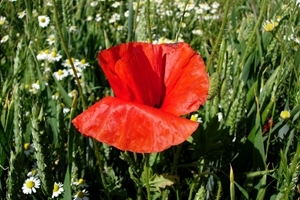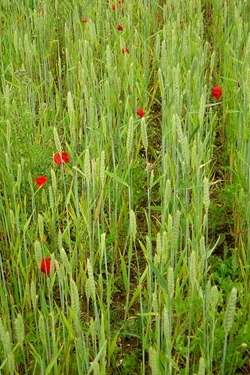Key points
- Insect and other invertebrate numbers are declining across Europe.
- This study looked at the importance of weeds in crops for invertebrate numbers.
- The number and diversity of invertebrates increased as arable weeds increased.
- Certain weed species were most beneficial for invertebrates, including annual meadowgrass, common knotgrass and chickweed.
- Small changes to the way wheat is managed could make a big difference to farmland biodiversity.
Background
 Falling insect numbers across Europe have been reported widely in the past few years, with a focus on the services that they can provide to humans, such as pollination. These issues reflect a wider concern across the scientific community that invertebrate numbers and diversity are declining rapidly. Changing practice in agriculture is thought to be one of the driving forces behind this, and the need for improvement has long been recognised, but practice changes slowly on the ground and the declines continue. The number and diversity of plants (including weeds), insects and birds are all falling on farmland.
Falling insect numbers across Europe have been reported widely in the past few years, with a focus on the services that they can provide to humans, such as pollination. These issues reflect a wider concern across the scientific community that invertebrate numbers and diversity are declining rapidly. Changing practice in agriculture is thought to be one of the driving forces behind this, and the need for improvement has long been recognised, but practice changes slowly on the ground and the declines continue. The number and diversity of plants (including weeds), insects and birds are all falling on farmland.
This study looks at winter wheat, the most widespread global crop, to investigate the link between weeds in crops and invertebrate numbers on farmland. People need food, and with the growing global population farmers need good crop yields to provide it. This must be balanced with improved sustainability of agriculture to support and preserve biodiversity. Lots of work on farmland biodiversity has looked at the perimeter of fields, hedgerows and woodlands, but there can also be an important role for the cropped area in supporting farmland biodiversity.
However, this approach is not popular with farmers, who tend to choose agri-environment options that focus on the areas of their farm where crops are not grown – for example hedgerows, woodland and headlands. The diversity of arable plants in the UK has been falling, with many previously common weed species are now very rare and some are in danger of extinction, such as corn buttercup and pheasant’s-eye. This is thought to be largely due to the widespread of herbicides (weed killers) and the development of more effective products, as well as changes in farming practice towards techniques such as autumn cropping, which favour a few common species such as blackgrass over the rarer spring-germinating ones.
What they did
The scientists took the raw data from seven other published studies of winter wheat crops in the UK, over an 18-year period. All these studies recorded both species and abundance of arable weeds and invertebrates at the same place, by the same people.
This allowed the scientists to carry out a re-analysis of the combined data to explore the relationship between the species of weed, how much ground was covered by weeds, and the type of invertebrates present. They were able to identify the most common weeds, weed cover across the studies, and which species or groups of species were beneficial for which invertebrates.
They examined the effect of weed cover on invertebrates that eat plants, those that are predatory, eating other invertebrates, as well as those that provide food for farmland birds as measured in the Chick Food Index, either specifically for grey partridges (the CFI), or more generally (the Generalised Bird Chick Food Index, GBCFI).
The paper also attempted to identify a weed “threshold” at which there was sufficient cover of weeds. For this they used the CFI, which at a level of 0.7 is known to provide enough insect food to support grey partridge broods.
What they found
Average weed cover varied between sites, from as low as 2.7% ground cover to 29%. The composition of weed species also varied, but most common were annual meadowgrass and knotgrass, followed by chickweed, black grass and the field pansy. The most common invertebrates were spiders, beetles and flies, followed by bugs and parasitic wasps.
All groups of invertebrates increased as arable weeds increased. The relationship was stronger for invertebrates that eat plants, compared to those that are predatory, but both groups increased with weed cover. Both chick food indexes also rose with increased weed cover.
In terms of which weed species support the most invertebrate species, annual meadowgrass, common knotgrass and chickweed appear to be the most desirable, also taking into their impact on crop production.
What does this mean?
 There was a lot of variation between the different studies, but overall conclusions can be drawn. These are that, in general, more weeds in crops means more invertebrates. This translates to more food for farmland birds and may mean more food for pollinators and more natural control of crop pests (biological control).
There was a lot of variation between the different studies, but overall conclusions can be drawn. These are that, in general, more weeds in crops means more invertebrates. This translates to more food for farmland birds and may mean more food for pollinators and more natural control of crop pests (biological control).
Weeds in crops can provide important ecosystem services, by supporting invertebrates that perform pollination and pest control, as well as forming a fundamental part of the food chain that species such as farmland birds rely on. This study identified the weed species that are most beneficial to farmland invertebrate groups, as well as those that are less so, and this knowledge may allow farmers the confidence to tolerate certain arable plants that do not threaten their farming operation, knowing that these help support invertebrates, and therefore other farmland wildlife such as birds.
This study and its important findings highlight the power of combined studies and long-term data sets, to reveal those detailed findings that may not be possible to tease out in a single study. Bringing together data from many individually valuable studies, including long-term monitoring such as that carried out in the Sussex Study, enhances our ability to use the data from each one and maximises its research potential. Funding for this kind of analytical research is critical, as well as financing the original studies that form the building blocks of such work, yet can be challenging to secure.
Read the original paper
Smith BM, Aebischer NJ, Ewald J, Moreby S, Potter C and Holland JM (2020) The potential of arable weeds to reverse invertebrate declines and associated ecosystem services in cereal crops. Frontiers in Sustainable Food Systems, 3, 118.